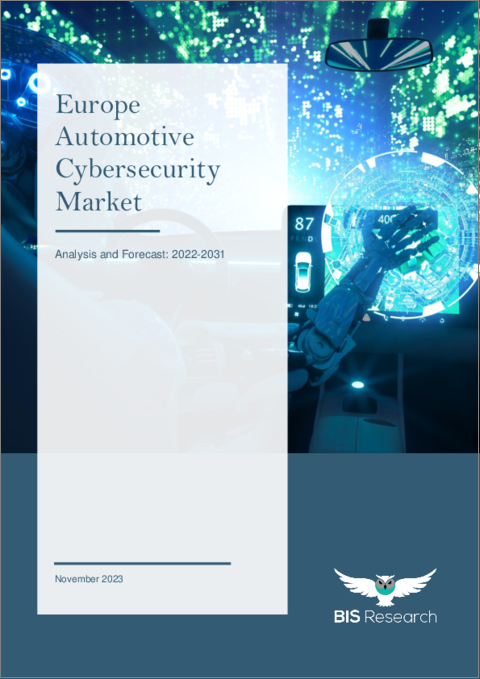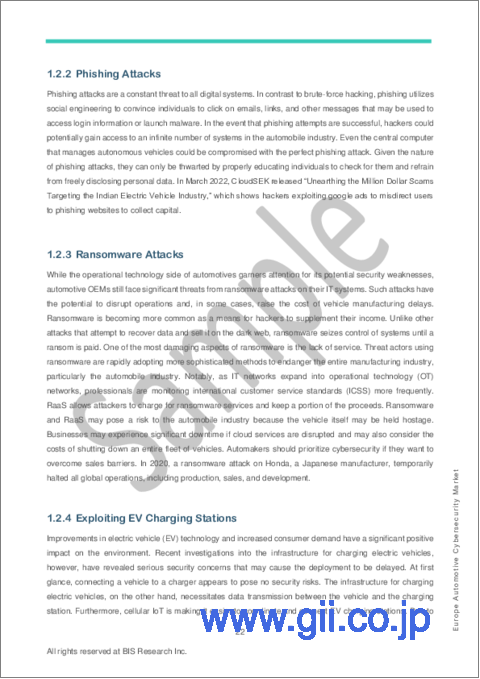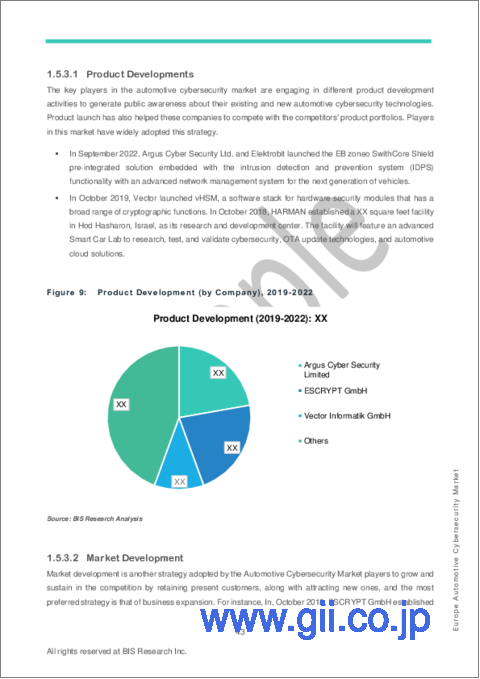|
|
市場調査レポート
商品コード
1389586
欧州の自動車サイバーセキュリティ市場の分析・予測:2022-2031年Europe Automotive Cybersecurity Market - Analysis and Forecast, 2022-2031 |
||||||
カスタマイズ可能
|
|||||||
| 欧州の自動車サイバーセキュリティ市場の分析・予測:2022-2031年 |
|
出版日: 2023年12月01日
発行: BIS Research
ページ情報: 英文 114 Pages
納期: 1~5営業日
|
全表示
- 概要
- 図表
- 目次
英国を除く欧州の自動車サイバーセキュリティの市場規模は、2022年の7億9,350万米ドルから、予測期間中は24.08%のCAGRで推移し、2031年には55億3,330万米ドルの規模に成長すると予測されています。
コネクテッドカーの増加、車両あたりの電子機器の採用の増加、車両のデータと接続性の増加によるサイバー脅威の増加、電気自動車の販売台数の増加などの要因から、自動車サイバーセキュリティは、欧州で大きく成長すると予想されています。
当レポートでは、欧州の自動車サイバーセキュリティの市場を調査し、市場の背景・概要、市場成長への各種影響因子の分析、法規制環境、特許動向、主な脅威、ケーススタディ、市場規模の推移・予測、各種区分・主要国別の詳細分析、競合情勢、主要企業の分析などをまとめています。
| 主要市場統計 | |
|---|---|
| 予測期間 | 2022-2031年 |
| 2022年評価 | 7億9,350万米ドル |
| 2031年予測 | 55億3,330万米ドル |
| CAGR | 24.08% |
市場の分類
セグメンテーション1:用途別
- 通信
- ADASおよび安全システム
- オンボード診断 (OBD)
- インフォテインメント
- テレマティクス
- EV充電ステーション
- その他
セグメンテーション2:自動車タイプ別
- 乗用車
- 商用車
セグメンテーション3:セキュリティタイプ別
- ネットワークセキュリティ
- ソフトウェアセキュリティ
- クラウドセキュリティ
- ハードウェアセキュリティ
セグメンテーション4:形態別
- 車載
- 外部クラウドサービス
セグメンテーション5:地域別
- 欧州
- 英国
主要企業:
- ESCRYPT GmbH
- Vector Informatik GmbH
- Irdeto
- Garrett Motion Inc.
- Aptiv PLC
- NXP Semiconductors
目次
第1章 市場
- 業界の展望
- サプライチェーン
- 業界の動向
- エコシステム/進行中のプログラム
- 規制状況
- 自動車サイバーセキュリティ標準
- 主要な特許のマッピング
- 自動車サイバーセキュリティ市場のロードマップ
- 主な自動車サイバーセキュリティ脅威の分析
- ブルートフォース攻撃
- フィッシング攻撃
- ランサムウェア攻撃
- EV充電ステーション攻撃
- テレマティクスサイバーセキュリティ
- キーレス車の盗難
- インフォテインメントシステムのハッキング
- 自動車サイバーセキュリティ攻撃ベクトル
- インフォテイメント
- グリッドチャージング (EV充電ステーション)
- OBDツール
- レーダー
- カメラ
- ネットワーク接続・クラウドサーバー
- ケーススタディ
- 事業力学
- 事業促進要因
- 事業上の課題
- 事業戦略
- 事業機会
- 企業戦略
- COVID-19による自動車サイバーセキュリティ市場への影響
第2章 地域
- 欧州
- 市場
- 用途
- 製品
- 欧州 (国別)
- 英国
- 市場
- 用途
- 製品
第3章 市場:競合ベンチマーキング・企業プロファイル
- 競合ベンチマーキング
- 市場シェア分析
- 企業プロファイル
- 非公開会社
- 公開会社
第4章 調査手法
List of Figures
- Figure 1: Automotive Cybersecurity Market Overview, $Million, 2021-2031
- Figure 2: Automotive Cybersecurity Market (by Application), $Million, 2021-2031
- Figure 3: Automotive Cybersecurity Market (by Vehicle Type), $Million, 2021-2031
- Figure 4: Automotive Cybersecurity Market (by Security Type), $Million, 2021-2031
- Figure 5: Automotive Cybersecurity Market (by Form), $Million, 2021-2031
- Figure 6: Automotive Cybersecurity Market (by Region), $Million, 2021
- Figure 7: Automotive Cybersecurity Market Supply Chain
- Figure 8: Automotive Cybersecurity Ecosystem
- Figure 9: Automotive Cybersecurity Standards
- Figure 10: Roadmap of the Automotive Cybersecurity Market
- Figure 11: Automotive Cybersecurity Attack Vectors
- Figure 12: Automotive Cybersecurity Market, Business Dynamics
- Figure 13: Impact of Business Drivers
- Figure 14: Impact of Business Restraints
- Figure 15: Share of Key Business Strategies, 2019-2022
- Figure 16: Product Development (by Company), 2019-2022
- Figure 17: Share of Key Corporate Strategies, 2019-2022
- Figure 18: Partnerships, Joint Ventures, Collaborations, and Alliances (by Company), 2019-2022
- Figure 19: Impact of Business Opportunities
- Figure 20: Competitive Benchmarking for the Automotive Cybersecurity Market, 2021
- Figure 21: Aptiv PLC: R&D Expenditure, $Billion, 2019-2021
- Figure 22: NXP Semiconductors: R&D Expenditure, $Billion, 2019-2021
- Figure 23: Data Triangulation
- Figure 24: Top-Down and Bottom-Up Approach
- Figure 25: Assumptions and Limitations
List of Tables
- Table 1: Automotive Cybersecurity Market Overview
- Table 2: Key Companies Profiled
- Table 3: Key Stakeholders in the Automotive Cybersecurity Market Supply Chain
- Table 4: Consortiums, Associations, and Regulatory Bodies
- Table 5: Government Programs and Initiatives
- Table 6: Programs by Research Institutions and Universities
- Table 7: Key Patent Mapping
- Table 8: Automotive Cybersecurity Market (by Region), $Million, 2021-2031
- Table 9: Europe Automotive Cybersecurity Market (by Application), $Million, 2021-2031
- Table 10: Europe Automotive Cybersecurity Market (by Vehicle Type), $Million, 2021-2031
- Table 11: Europe Automotive Cybersecurity Market (by Security Type), $Million, 2021-2031
- Table 12: Europe Automotive Cybersecurity Market (by Form), $Million, 2021-2031
- Table 13: Germany Automotive Cybersecurity Market (by Application), $Million, 2021-2031
- Table 14: Germany Automotive Cybersecurity Market (by Vehicle Type), $Million, 2021-2031
- Table 15: Germany Automotive Cybersecurity Market (by Security Type), $Million, 2021-2031
- Table 16: Germany Automotive Cybersecurity Market (by Form), $Million, 2021-2031
- Table 17: France Automotive Cybersecurity Market (by Application), $Million, 2021-2031
- Table 18: France Automotive Cybersecurity Market (by Vehicle Type), $Million, 2021-2031
- Table 19: France Automotive Cybersecurity Market (by Security Type), $Million, 2021-2031
- Table 20: France Automotive Cybersecurity Market (by Form), $Million, 2021-2031
- Table 21: Italy Automotive Cybersecurity Market (by Application), $Million, 2021-2031
- Table 22: Italy Automotive Cybersecurity Market (by Vehicle Type), $Million, 2021-2031
- Table 23: Italy Automotive Cybersecurity Market (by Security Type), $Million, 2021-2031
- Table 24: Italy Automotive Cybersecurity Market (by Form), $Million, 2021-2031
- Table 25: Rest-of-Europe Automotive Cybersecurity Market (by Application), $Million, 2021-2031
- Table 26: Rest-of-Europe Automotive Cybersecurity Market (by Vehicle Type), $Million, 2021-2031
- Table 27: Rest-of-Europe Automotive Cybersecurity Market (by Security Type), $Million, 2021-2031
- Table 28: Rest-of-Europe Automotive Cybersecurity Market (by Form), $Million, 2021-2031
- Table 29: U.K. Automotive Cybersecurity Market (by Application), $Million, 2021-2031
- Table 30: U.K. Automotive Cybersecurity Market (by Vehicle Type), $Million, 2021-2031
- Table 31: U.K. Automotive Cybersecurity Market (by Security Type), $Million, 2021-2031
- Table 32: U.K. Automotive Cybersecurity Market (by Form), $Million, 2021-2031
- Table 33: Market Share Analysis for the Automotive Cybersecurity Market, 2021
- Table 34: ESCRYPT GmbH: Product and Service Portfolio
- Table 35: ESCRYPT GmbH: Partnerships, Joint Ventures, Collaborations, and Alliances
- Table 36: ESCRYPT GmbH: Product Development
- Table 37: ESCRYPT GmbH: Market Development
- Table 38: Vector Informatik GmbH: Product and Service Portfolio
- Table 39: Vector Informatik GmbH: Partnerships, Joint Ventures, Collaborations, and Alliances
- Table 40: Vector Informatik GmbH: Mergers and Acquisitions
- Table 41: Vector Informatik GmbH: Product Development
- Table 42: Irdeto: Product and Service Portfolio
- Table 43: Garrett Motion Inc.: Product and Service Portfolio
- Table 44: Garrett Motion Inc.: Product Development
- Table 45: Aptiv PLC: Product and Service Portfolio
- Table 46: Aptiv PLC: Mergers and Acquisitions
- Table 47: NXP Semiconductors: Product and Service Portfolio
- Table 48: NXP Semiconductors: Partnerships, Joint Ventures, Collaborations, and Alliances
“The Europe Automotive Cybersecurity Market (excluding U.K.) Expected to Reach $5,533.3 Million by 2031.”
Introduction to Europe Automotive Cybersecurity Market
The Europe automotive cybersecurity market (excluding U.K.) was valued at $793.5 million in 2022, and it is expected to grow at a CAGR of 24.08% and reach $5,533.3 million by 2031. Automotive cybersecurity is expected to grow significantly in Europe. This growth will be primarily driven by factors like the growing number of connected vehicles, the increasing adoption of electronics per vehicle, the increased cyber threats resulting from increased data and connectivity of vehicles, and the rising sales of electric vehicles.
Market Introduction
| KEY MARKET STATISTICS | |
|---|---|
| Forecast Period | 2022 - 2031 |
| 2022 Evaluation | $793.5 Million |
| 2031 Forecast | $5,533.3 Million |
| CAGR | 24.08% |
Numerous factors, including the growing number of ECUs in electric vehicles for improved performance and sophistication, the rise in cyberattacks targeting the automotive sector, and the expanding use of connected and autonomous vehicles, are driving the automotive cybersecurity market.
In order to counteract the increasing number of cyber-attack vectors, automotive cybersecurity solution providers are collaborating with other important stakeholders and making large investments in the creation of cutting-edge automotive cybersecurity solutions. The automotive cybersecurity industry is anticipated to increase significantly over the forecast years due to OEMs' growing worries about vehicle security.
Market Segmentation
Segmentation 1: by Application
- Communication
- Advanced Driver Assistance System (ADAS) and Safety System
- On-Board Diagnostic (OBD)
- Infotainment
- Telematics
- EV Charging Station
- Others
Segmentation 2: by Vehicle Type
- Passenger Vehicle
- Commercial Vehicle
Segmentation 3: by Security Type
- Network Security
- Software Security
- Cloud Security
- Hardware Security
Segmentation 4: by Form
- In-Vehicle
- External Cloud Services
Segmentation 5: by Region
- Europe
- U.K.
How can this report add value to an organization?
Product/Innovation Strategy: In Europe, the leading and emerging automotive cybersecurity solution providers are continuously working to make their vehicles more secure than ever. The threat of unauthorized access and vehicle data theft are among some of the most talked about concerns in the automotive cybersecurity industry. The players operating in the automotive cybersecurity market have been working on the development of advanced vehicle cybersecurity solutions using artificial intelligence (AI), machine learning (ML), blockchain, and hardware authentication technologies and techniques. These innovative automotive vehicle cybersecurity solutions are expected to mitigate the growing number of cyber-attacks on vehicles.
Growth/Marketing Strategy: The automotive cybersecurity market has been growing at a rapid pace. The market offers enormous opportunities for existing and emerging market players. Some of the strategies covered in this segment are product launches, partnerships, collaborations, business expansions, and investments. The strategies preferred by companies to maintain and strengthen their market position primarily include product launches, partnerships, and collaborations.
Competitive Strategy: The key players in the Europe automotive cybersecurity market analyzed and profiled in the study include automotive cybersecurity solution providers that develop, maintain, and market automotive cybersecurity solutions. Moreover, a detailed competitive benchmarking of the players operating in the automotive cybersecurity market has been done to help the reader understand the ways in which players stack against each other, presenting a clear market landscape. Additionally, comprehensive competitive strategies such as partnerships, agreements, and collaborations will aid the reader in understanding the untapped revenue pockets in the market.
Key Market Players and Competition Synopsis
The companies that are profiled have been selected based on inputs gathered from primary experts and analysing company coverage, product portfolio, and market penetration.
Some of the prominent names established in this market are:
|
|
Table of Contents
1 Markets
- 1.1 Industry Outlook
- 1.1.1 Supply Chain
- 1.1.2 Industry Trends
- 1.1.2.1 Increasing Adoption of the Connected Vehicle and Autonomous Driving Technology by Manufacturers
- 1.1.2.2 Increasing Focus on V2X Equipped Vehicles in the Connected Vehicle Industry
- 1.1.2.3 Growing Demand for Cloud-Based Applications in the Automotive Industry
- 1.1.3 Ecosystem/Ongoing Programs
- 1.1.3.1 Consortiums, Associations, and Regulatory Bodies
- 1.1.3.2 Government Programs and Initiatives
- 1.1.3.3 Programs by Research Institutions and Universities
- 1.1.4 Regulatory Landscape
- 1.1.4.1 Europe
- 1.1.4.1.1 European Union (EU)
- 1.1.4.1.2 Federal Office for Information Security - Germany
- 1.1.4.2 U.K.
- 1.1.4.1 Europe
- 1.1.5 Automotive Cybersecurity Standards
- 1.1.5.1 ISO/SAE 21434
- 1.1.5.2 UNECE UN R155 and UN R156
- 1.1.5.3 MIIT CN ICV Access Guide
- 1.1.6 Key Patent Mapping
- 1.1.7 Roadmap of the Automotive Cybersecurity Market
- 1.2 Analysis of Prominent Automotive Cybersecurity Threats
- 1.2.1 Brute Force Attack
- 1.2.2 Phishing Attacks
- 1.2.3 Ransomware Attacks
- 1.2.4 Exploiting EV Charging Stations
- 1.2.5 Telematics Cybersecurity
- 1.2.6 Keyless Car Theft
- 1.2.7 Hacking Infotainment Systems
- 1.3 Automotive Cybersecurity Attack Vectors
- 1.3.1 Infotainment
- 1.3.2 Grid Charging (EV Charging Station)
- 1.3.3 OBD Tools
- 1.3.4 Radar
- 1.3.5 Camera
- 1.3.6 Network Connectivity and Cloud Servers
- 1.3.6.1 Connected Vehicle Technology and Communication Systems
- 1.3.6.1.1 Vehicle-to-Infrastructure (V2I)
- 1.3.6.1.2 Vehicle-to-Vehicle (V2V)
- 1.3.6.1.3 Global Navigation Satellite System (GNSS)
- 1.3.6.2 Communication Channels
- 1.3.6.2.1 Internet of Things
- 1.3.6.2.2 Cloud Servers
- 1.3.6.1 Connected Vehicle Technology and Communication Systems
- 1.4 Case Study
- 1.4.1 Case Study 1: Security Risk Assessment to Enable Safe Digital Growth
- 1.4.2 Case Study 2: Securing V2X Communications with HSM
- 1.4.3 Case Study 3: Threat Assessment for Connected Vehicles
- 1.4.4 Case Study 4: Secure Remote Firmware Updates and ECU Integrity Protection
- 1.4.5 Case Study 5: Vehicle Electrical/Electronic (EE) Architectures
- 1.5 Business Dynamics
- 1.5.1 Business Drivers
- 1.5.1.1 Increase in Use of Electronics Per Vehicle and Growing Number of Connected Vehicles
- 1.5.1.2 Rising Cyber Threats owing to Increase in Data and Connectivity of the Vehicles
- 1.5.1.3 Rising Sales of Electric Vehicles
- 1.5.2 Business Restraints
- 1.5.2.1 Growing Complexity and Increase in Number of Electronics in Vehicles
- 1.5.2.2 Financial Impacts due to Vulnerability and Growing Motivation of Cyberhackers
- 1.5.2.3 Highly Complex Ecosystem with the Presence of Multiple Stakeholders
- 1.5.2.4 High Costs of Automotive Cybersecurity Solutions
- 1.5.2.5 Semiconductor Shortage Effect
- 1.5.3 Business Strategies
- 1.5.3.1 Product Developments
- 1.5.3.2 Market Development
- 1.5.4 Corporate Strategies
- 1.5.4.1 Partnerships, Joint Ventures, Collaborations, and Alliances
- 1.5.4.2 Mergers and Acquisitions
- 1.5.5 Business Opportunities
- 1.5.5.1 Rising Demand for Advanced Cybersecurity Solutions and Technological Developments in Autonomous Vehicles
- 1.5.5.2 Introduction of Electric Vehicle Wireless Battery Management
- 1.5.6 COVID-19 Impact on the Automotive Cybersecurity Market
- 1.5.1 Business Drivers
2 Regions
- 2.1 Europe
- 2.1.1 Market
- 2.1.1.1 Buyer Attributes
- 2.1.1.2 Key Solution Providers in Europe
- 2.1.1.3 Business Challenges
- 2.1.1.4 Business Drivers
- 2.1.2 Applications
- 2.1.2.1 Europe Automotive Cybersecurity Market Demand (by Application), Value Data
- 2.1.2.2 Europe Automotive Cybersecurity Market Demand (by Vehicle Type), Value Data
- 2.1.3 Products
- 2.1.3.1 Europe Automotive Cybersecurity Market Demand (by Security Type), Value Data
- 2.1.3.2 Europe Automotive Cybersecurity Market Demand (by Form), Value Data
- 2.1.4 Europe (by Country)
- 2.1.4.1 Germany
- 2.1.4.1.1 Market
- 2.1.4.1.1.1 Buyers Attributes
- 2.1.4.1.1.2 Key Solution Providers in Germany
- 2.1.4.1.1.3 Business Challenges
- 2.1.4.1.1.4 Business Drivers
- 2.1.4.1.2 Applications
- 2.1.4.1.2.1 Germany Automotive Cybersecurity Market Demand (by Application), Value Data
- 2.1.4.1.2.2 Germany Automotive Cybersecurity Market Demand (by Vehicle Type), Value Data
- 2.1.4.1.3 Products
- 2.1.4.1.3.1 Germany Automotive Cybersecurity Market Demand (by Security Type), Value Data
- 2.1.4.1.3.2 Germany Automotive Cybersecurity Market Demand (by Form), Value Data
- 2.1.4.1.1 Market
- 2.1.4.2 France
- 2.1.4.2.1 Market
- 2.1.4.2.1.1 Buyers Attributes
- 2.1.4.2.1.2 Key Solution Providers in France
- 2.1.4.2.1.3 Business Challenges
- 2.1.4.2.1.4 Business Drivers
- 2.1.4.2.2 Applications
- 2.1.4.2.2.1 France Automotive Cybersecurity Market Demand (by Application), Value Data
- 2.1.4.2.2.2 France Automotive Cybersecurity Market Demand (by Vehicle Type), Value Data
- 2.1.4.2.3 Products
- 2.1.4.2.3.1 France Automotive Cybersecurity Market Demand (by Security Type), Value Data
- 2.1.4.2.3.2 France Automotive Cybersecurity Market Demand (by Form), Value Data
- 2.1.4.2.1 Market
- 2.1.4.3 Italy
- 2.1.4.3.1 Market
- 2.1.4.3.1.1 Buyers Attributes
- 2.1.4.3.1.2 Key Solution Providers in Italy
- 2.1.4.3.1.3 Business Challenges
- 2.1.4.3.1.4 Business Drivers
- 2.1.4.3.2 Applications
- 2.1.4.3.2.1 Italy Automotive Cybersecurity Market Demand (by Application), Value Data
- 2.1.4.3.2.2 Italy Automotive Cybersecurity Market Demand (by Vehicle Type), Value Data
- 2.1.4.3.3 Products
- 2.1.4.3.3.1 Italy Automotive Cybersecurity Market Demand (by Security Type), Value Data
- 2.1.4.3.3.2 Italy Automotive Cybersecurity Market Demand (by Form), Value Data
- 2.1.4.3.1 Market
- 2.1.4.4 Rest-of-Europe
- 2.1.4.4.1 Market
- 2.1.4.4.1.1 Buyers Attributes
- 2.1.4.4.1.2 Key Solution Providers in the Rest-of-Europe
- 2.1.4.4.1.3 Business Challenges
- 2.1.4.4.1.4 Business Drivers
- 2.1.4.4.2 Applications
- 2.1.4.4.2.1 Rest-of-Europe Automotive Cybersecurity Market Demand (by Application), Value Data
- 2.1.4.4.2.2 Rest-of-Europe Automotive Cybersecurity Market Demand (by Vehicle Type), Value Data
- 2.1.4.4.3 Products
- 2.1.4.4.3.1 Rest-of-Europe Automotive Cybersecurity Market Demand (by Security Type), Value Data
- 2.1.4.4.3.2 Rest-of-Europe Automotive Cybersecurity Market Demand (by Form), Value Data
- 2.1.4.4.1 Market
- 2.1.4.1 Germany
- 2.1.1 Market
- 2.2 U.K.
- 2.2.1 Market
- 2.2.1.1 Buyer Attributes
- 2.2.1.1.1 Key Manufacturers in the U.K
- 2.2.1.1.1.1 Business Challenges
- 2.2.1.1.1.2 Business Drivers
- 2.2.1.1.1 Key Manufacturers in the U.K
- 2.2.1.1 Buyer Attributes
- 2.2.2 Applications
- 2.2.2.1 U.K. Automotive Cybersecurity Market Demand (by Application), Value Data
- 2.2.2.2 U.K. Automotive Cybersecurity Market Demand (by Vehicle Type), Value Data
- 2.2.3 Products
- 2.2.3.1 U.K. Automotive Cybersecurity Market Demand (by Security Type), Value Data
- 2.2.3.2 U.K. Automotive Cybersecurity Market Demand (by Form), Value Data
- 2.2.1 Market
3 Markets - Competitive Benchmarking & Company Profiles
- 3.1 Competitive Benchmarking
- 3.1.1 Market Share Analysis
- 3.2 Company Profiles
- 3.2.1 Private Companies
- 3.2.1.1 ESCRYPT GmbH
- 3.2.1.1.1 Company Overview
- 3.2.1.1.2 Role of ESCRYPT GmbH in the Automotive Cybersecurity Market
- 3.2.1.1.3 Product Portfolio
- 3.2.1.1.4 Corporate Strategies
- 3.2.1.1.4.1 ESCRYPT GmbH: Partnerships, Joint Ventures, Collaborations, and Alliances
- 3.2.1.1.5 Business Strategies
- 3.2.1.1.5.1 ESCRYPT GmbH: Product Development
- 3.2.1.1.5.2 ESCRYPT GmbH: Market Development
- 3.2.1.1.6 Analyst View
- 3.2.1.2 Vector Informatik GmbH
- 3.2.1.2.1 Company Overview
- 3.2.1.2.2 Role of Vector Informatik GmbH in the Automotive Cybersecurity Market
- 3.2.1.2.3 Product Portfolio
- 3.2.1.2.4 Corporate Strategies
- 3.2.1.2.4.1 Vector Informatik GmbH: Partnerships, Joint Ventures, Collaborations, and Alliances
- 3.2.1.2.4.2 Vector Informatik GmbH: Merges and Acquisitions
- 3.2.1.2.5 Business Strategies
- 3.2.1.2.5.1 Vector Informatik GmbH: Product Development
- 3.2.1.2.6 Analyst View
- 3.2.1.3 Irdeto
- 3.2.1.3.1 Company Overview
- 3.2.1.3.2 Role of Irdeto in the Automotive Cybersecurity Market
- 3.2.1.3.3 Product Portfolio
- 3.2.1.3.4 Analyst View
- 3.2.1.1 ESCRYPT GmbH
- 3.2.2 Public Companies
- 3.2.2.1 Garrett Motion Inc.
- 3.2.2.1.1 Company Overview
- 3.2.2.1.2 Role of Garrett Motion Inc. in the Automotive Cybersecurity Market
- 3.2.2.1.3 Product Portfolio
- 3.2.2.1.4 Business Strategies
- 3.2.2.1.4.1 Garrett Motion Inc.: Product Development
- 3.2.2.1.5 Analyst View
- 3.2.2.2 Aptiv PLC
- 3.2.2.2.1 Company Overview
- 3.2.2.2.2 Role of Aptiv PLC in the Automotive Cybersecurity Market
- 3.2.2.2.3 Product Portfolio
- 3.2.2.2.4 Corporate Strategies
- 3.2.2.2.4.1 Aptiv PLC: Merges and Acquisitions
- 3.2.2.2.5 R&D Analysis
- 3.2.2.2.6 Analyst View
- 3.2.2.3 NXP Semiconductors
- 3.2.2.3.1 Company Overview
- 3.2.2.3.2 Role of NXP Semiconductors in the Automotive Cybersecurity Market
- 3.2.2.3.3 Product Portfolio
- 3.2.2.3.4 Corporate Strategies
- 3.2.2.3.4.1 NXP Semiconductors: Partnerships, Joint Ventures, Collaborations, and Alliances
- 3.2.2.3.5 R&D Analysis
- 3.2.2.3.6 Analyst View
- 3.2.2.1 Garrett Motion Inc.
- 3.2.1 Private Companies
4 Research Methodology
- 4.1 Data Sources
- 4.1.1 Primary Data Sources
- 4.1.2 Secondary Data Sources
- 4.1.3 Data Triangulation
- 4.2 Market Estimation and Forecast
- 4.2.1 Factors for Data Prediction and Modeling






